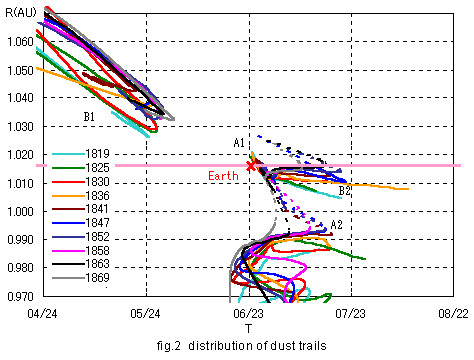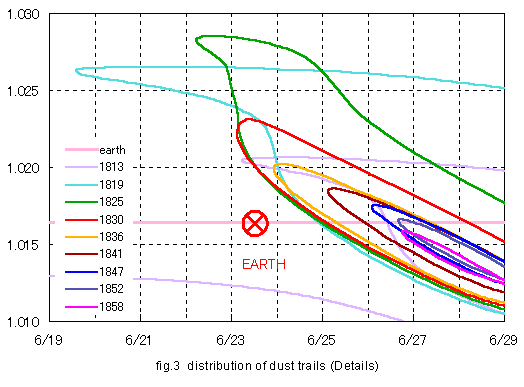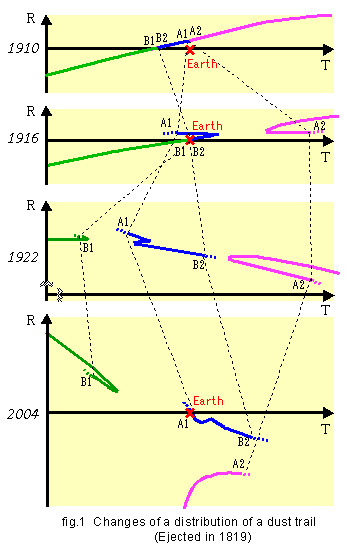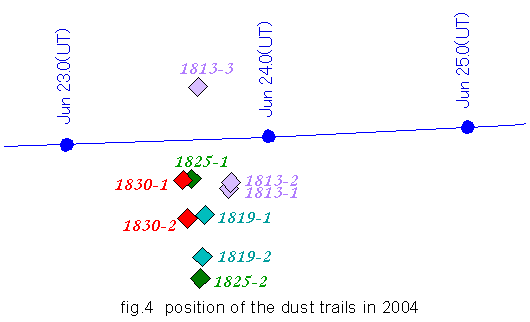


The distribution of the dust trais are shown in fig.2. Some parts of trails are likely to approach with the earth. Fig.3 is an expansion display in a part of fig.2.


| Year of ejection | Discharge speed [m/s] | Date | Time | delta r [AU] | Alpha | Delta | Velocity [km/s] |
|---|---|---|---|---|---|---|---|
| 1830-1 | 8.155 | Jun. 23 | 13:45 | +0.0033 | 223.0 | +47.1 | 14.14 |
| 1830-2 | 8.169 | Jun. 23 | 14:17 | +0.0064 | 223.5 | +47.3 | 14.12 |
| 1825-1 | 8.834 | Jun. 23 | 14:46 | +0.0031 | 223.0 | +47.0 | 14.13 |
| 1825-2 | 8.859 | Jun. 23 | 15:36 | +0.0115 | 224.2 | +47.6 | 14.08 |
| 1819-1 | 10.377 | Jun. 23 | 16:32 | +0.0062 | 223.4 | +47.2 | 14.10 |
| 1819-2 | 10.388 | Jun. 23 | 16:29 | +0.0098 | 224.0 | +47.6 | 14.09 |
| 1813-3(1* | 13.166 | Jun. 23 | 16:09 | -0.0040(2* | 221.6 | +46.7 | 14.17 |
| 1813-2 | 13.290 | Jun. 23 | 19:32 | +0.0034 | 223.1 | +46.9 | 14.10 |
| 1813-1(1* | 13.291 | Jun. 23 | 19:15 | +0.0045(2* | 223.1 | +47.0 | 14.10 |

Therefore, the meteor shower in 2004 is expected about 13:00 - 20:00(UT) on Jun. 23. However, since the trails are disturbed, the hourly rate in 2004 will be fewer than that in 1998.
Addition 1;
This result is from the method assumes the meteoroid stream to be formed as a comet passes perihelion. If dust is ejectted before and after perihelion, it may approach more nearly to earth. In this case, the difference for dozens of minutes will arise at the peak time.
Addition 2;
The meteor from other trails (ejected after 1836) may appear if these distributions of trails are large.

| Year of ejection (1* | Time difference with perihelion [day] | Discharge speed [m/s] | Date | Time (UT) | R.P. | Velocity [km/s] | |
|---|---|---|---|---|---|---|---|
| Alpha | Delta | ||||||
| 1830 | -104.8(2* | 13.81 | Jun. 23 | 12:30 | 222.5 | 46.8 | 14.14 |
| 1825 | -74.7 | 12.72 | Jun. 23 | 13:45 | 222.4 | 46.8 | 14.13 |
| 1819 | -60.1(2* | 13.57 | Jun. 23 | 15:31 | 222.5 | 46.7 | 14.12 |
From the above result, a possibility that meteor would appear was suggested around 12:00-16:00(UT). However, the activity of a comet when dust was ejectted is about 20% (1830) - 40% (1819) at the time of perihelion.